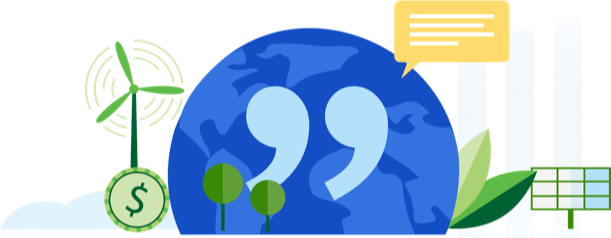The Clean Energy Future Blog
By Coalition for Green Capital
Environmental Groups, Trade and Industry Associations, Utility Companies, Financial Institutions, and State and Local Governments Call On Biden To Jumpstart a $600B Clean Energy Market by Supporting the Greenhouse Gas Reduction Fund
WASHINGTON, DC— In a new letter to President Joe Biden, 210 organizations and companies requested the President’s support in passing legislation to fund a national green bank in the form of the Greenhouse Gas Reduction Fund, formally known as the Clean Energy and Sustainability Accelerator. Signers of the letter included national environmental advocates, trade and industry associations, financial institutions, utility companies, and state and local governments.
Appealing to President Biden’s efforts to increase American energy independence, lower energy costs, and fight climate change, the letter outlined the immediate and direct impact that legislation could have on local communities.
“Given the dual crises we are now facing—from the stark reminder in Ukraine of our reliance on fuels with volatile prices, to climate change increasingly outpacing our ability to adapt—we write now to urge your support for final passage of climate investment in the House-passed Build Back Better Act, specifically the Greenhouse Gas Reduction Fund (previously, the Clean Energy and Sustainability Accelerator). This Fund, as proposed, will drive financing products into the market that save households hundreds or even thousands of dollars a year while accelerating the transition to clean energy and mitigating the impacts of climate change.
The letter also detailed how the Fund would work with local lenders and financial institutions to direct resources to frontline and low-income communities and catalyze public-private investments for clean energy projects.
“Hundreds of local community lenders like CDFIs and credit unions want to increase local investment in clean energy solutions and would seek that capital and coordination from a national green bank. Together, this Fund, state and local green banks, and community lenders will work collectively to lower energy costs and deliver energy independence for all consumers in the U.S., with 40% set aside for low-to-moderate income households. Existing green banks have already built a track record of delivering clean energy and health benefits to communities that have historically been forgotten.
“This Fund will pair each public dollar with multiple private ones to build a range of clean energy projects, including renewable power, building efficiency, distributed energy resources, grid infrastructure, energy storage, industrial decarbonization, clean transportation, reforestation and sustainable agriculture and climate-resilient infrastructure. Public dollars invested will be repaid and preserved by the Fund, meaning that those dollars can be recycled to create even more private investment in the future. This Fund would be a smart investment to jumpstart a national $600B market.”
Background
The national green bank was passed by the House of Representatives as part of the Build Back Better Act approved last fall. President Biden included the Clean Energy and Sustainability Accelerator, a national green bank that would inject funding into state green banks, as a key climate provision in the American Jobs Plan. The House also passed the Accelerator as part of the INVEST in America Act (H.R. 3684), marking the third time it passed with bipartisan support. Republicans voting in favor of the Accelerator include Congressmembers Don Bacon (NE-2), Brian Fitzpatrick (PA-1), Jeff Fortenberry (NE-1), John Katko (NY-24), Christopher Smith (NJ-4), Jefferson Van Drew (NJ-2), and Don Young (AK).
In a letter to congressional leaders urging action on climate infrastructure, over 140 mayors called for the creation of a national green bank. Earlier this month, 10 governors on the front lines of the climate crisis called on Congress to pass the Clean Energy and Sustainability Accelerator, because doing so would be one of “the most impactful actions to protect our climate” and environmental groups echoed that message.
By Coalition for Green Capital
Sharlene Brown, Raya Salter, and Jesse Glickstein Named as Inaugural Board Members
WASHINGTON, DC— Today, the Coalition for Green Capital (CGC) announced the formation of an Environmental Justice Advisory Board to guide the organization’s work to advance clean energy investments and prioritize a just transition for frontline communities and communities of color. Sharlene Brown, Raya Salter, and Jesse Glickstein were all named as inaugural members of the board.
“We are thrilled to announce the formation of CGC’s Environmental Justice Advisory Board,” said Jeffrey Schub, Executive Director of the Coalition for Green Capital. “The green bank model continues to build momentum as a proven model for catalyzing public and private investments and green banks around our country are generating historic investments for local clean energy projects. Our inaugural board members will provide critically important guidance and support as we continue our work to stand up green bank institutions and spur clean energy projects while prioritizing equity and environmental justice.”
The inaugural board will work directly with CGC’s recently named Chief Consultant of Environmental Justice and Equity, William J. Barber III in identifying strategies to effectively engage with frontline communities. Barber said of the members, “Each of these members bring diverse sets of experience and invaluable expertise in engaging LMI and BIPOC communities. CGC sees a window of opportunity to push the envelope on strategic involvement of communities in a way that yields real, tangible benefits.”
“The green bank model has uniquely emerged as a key tool for bringing clean energy projects to frontline communities and communities of color,” said Jill Bunting, Deputy Director of the Coalition for Green Capital. “The members of our Environmental Justice Advisory Board have strong track records of advancing environmental equity and social justice and their support will be invaluable to our work in the coming years.”
Priorities for the Board include:
- Investigating alternate underwriting criteria and financial models that allow for enhanced deployment of clean energy tech to frontline communities
- Identifying new metrics for program deployment that take into account equity considerations such as diversity in clean energy workforce development; alleviating energy burden for households, and expanding access to direct benefits associated with clean tech;
- Establishing an internal accountability structure to ensure CGC continues and strengthens its commitments to environmental justice and
- Engaging a broad network of organizations with track records of serving LMI/BIPOC/indigneous constituencies in frontline areas

Sharlene Brown is Senior Fellow at Croatan Institute and director of the Institute’s initiative on Racial Equity, Economics, Finance, and Sustainability (REEFS). Ms. Brown was previously the executive director of the Partnership for Responsible Financial Inclusion (PRFI), where she managed the strategic priorities of the member organizations and coordinated its working groups. Prior to that, she served as national director of Oikocredit-USA, where she raised investment capital and provided development education on microfinance and social performance to investors with more than US$35 million in assets. Ms. Brown also worked with the Grameen Foundation, a member of the Partnership for Responsible Financial Inclusion, as a senior program officer for their Social Performance Management Center, where she oversaw projects for microfinance institutions in sub-Saharan Africa and Middle- East/North Africa. She has also worked in the socially responsible investment marketplace as a business development manager for Domini Social Investments, and as research associate for the Social Investment Forum.

Raya Salter is an attorney, activist and clean energy law and policy expert with a focus on energy justice. She is also a member of the New York State Climate Action Council, the body that is developing New York’s climate scoping plan.
In previous roles, Raya was the Lead Policy Organizer for the NY Renews Climate Justice Coalition, a Senior Attorney at the Natural Resources Defense Council and a Regulatory Attorney for the Environmental Defense Fund. Raya was named one of the “Energy and the Environment Power 100” by City and State New York Magazine in 2020 and 2021. In 2021 she was honored by New York Lawyers for the Public Interest with the Fishman Access to Justice Award. Raya was named a “Climate Hero” by the Human Impacts Institute in 2019. Ms. Salter has a J.D. from Fordham University School of Law and a B.A. in economics from Wesleyan University.

Jesse Glickstein is the Environmental & Human Rights Counsel on the Global, Social, and Environmental Responsibility Team within the Ethics & Compliance Office at Hewlett Packard Enterprise Company. Jesse advises on a wide range of environmental, energy, conflict minerals, and human rights compliance, supply chain, and legal issues. Previously, Jesse practiced environmental law at an international law firm, O’Melveny & Myers, which included work on renewable energy project finance transactions and M&A deals. Jesse also co-founded Faiths United for Sustainable Energy, a non-profit that educated and mobilized faith-based communities around the intersection of issues related to the environment, climate change, social and economic justice, renewable energy, and religion. He has completed thousands of pro bono hours over the past several years, including work on a legal challenge to an inadequate environmental review process; legal proceedings representing unaccompanied immigrant children; and representation of a cooperative in drafting, analyzing, and negotiating power purchase agreements and regulatory filings in order to install solar systems, aggregate purchasing of electricity, and reduce costs for schools, religious institutions, and other non-profit institutions.
Social Justice and Environmental Advocate William J.Barber III Joins Coalition for Green Capital
By Coalition for Green Capital
| Washington, DC — Coalition for Green Capital today announced that William J. Barber III has been named its Chief Consultant of Environmental Justice and Equity. With nearly a decade of experience as an organizer, Barber will lead the organization’s work on environmental and climate justice. “We’re delighted to welcome William Barber III to our team,” said Reed Hundt, CEO of Coalition for Green Capital. “Mr. Barber brings a wealth of experience and knowledge to our organization and will be an integral part of our work to advance clean energy investments, especially in disadvantaged communities and communities of color.” “CGC has a long track-record of promoting environmental justice by expanding access to clean energy technology for BIPOC and LMI communities through the green bank model,” said Barber. “I am excited to join the effort to scale this model, focusing on innovative ways that climate finance can help advance social equity and create co-benefits for frontline communities.” In Barber’s previous roles, he facilitated campaign efforts to oppose the now defeated Atlantic Coast Pipeline, as well as participation of the NC Poor People’s Campaign as a filing party of a Title VI Complaint–recently accepted by the Environmental Protection Agency–that calls on a more stringent review of the environmental justice impacts of expanded permitting of biogas facilities in North Carolina. He also worked and collaborated with his father, Bishop William J. Barber II of the Poor People’s Campaign, to cultivate a partnership with The Climate Reality Project focused on amplifying the intersections of environmental and climate justice and poverty. Barber is currently a fellow for Environmental Justice and Civic Engagement at the Center for Earth Ethics. He received his B.S. in environmental physics from North Carolina Central University and earned his juris doctorate from the University of North Carolina at Chapel Hill School of law, where he focused on environmental law and policy. He is also founder and CEO of the Rural Beacon Initiative–a multi-member startup focused on accelerating participation of BIPOC and LMI communities in the clean economy. |
| ABOUT COALITION FOR GREEN CAPITAL The Coalition for Green Capital (@CGreenCapital) is a non-profit with a mission to halt climate change by accelerating investment in clean energy technologies and by advocating for, creating and implementing green bank institutions. Green banks are a proven finance model that uses public and philanthropic funds to mobilize private investment in renewable energy, energy efficiency and other decarbonization technologies. For over a decade, the Coalition for Green Capital has led the Green Bank movement, working at the federal, state and local level in the U.S. and in countries around the world. For more information, visit: https://coalitionforgreencapital.com/. |
By Coalition for Green Capital
Report Outlines Best Practices for Establishing a Green Bank in the State
| Washington, D.C.— The Coalition for Green Capital (CGC) applauds Minnesota Governor Tim Walz after he proposed the creation of a green bank that would finance clean energy projects in his state. The proposal comes just months after a CGC report outlined a path forward for the state of Minnesota to create the nonprofit financial entity. “With this proposal, Governor Walz is taking an important step to combat climate change,” said CGC Executive Director Jeffrey Schub. “CGC has been advocating for and working to create a Minnesota green bank since 2014 because it is a powerful and highly effective way to finance clean energy projects that may not receive funding from private investors–but are critical to meeting climate goals. We stand ready to support Minnesota as it seeks to join 22 other states in establishing a green bank.” The CGC report, “Minnesota Green Bank Capabilities and Implementation Path,” was released in October 2021 and noted that “a Minnesota green bank would fund projects including clean energy, building efficiency, grid infrastructure, industrial decarbonization, clean transportation, reforestation, regenerative agriculture, and climate-resilient infrastructure.” According to the report, a green bank could help address a lack of clean energy programs that are available to low to medium income communities in Minnesota and bring energy efficiency solar power and electric transportation options to these communities in particular. Green banks drove a record amount of clean energy investment in 2020, mobilizing $1.69 billion of total investment with $442 million of green bank funds, according to the American Green Bank Consortium’s annual reportreleased last May. In total, this brings cumulative green bank investment to $7 billion using $1.9 billion green bank funds. A green bank uses public capital to mobilize more private investment into underserved green and resilient financing markets to fill market gaps. Green banks have the ultimate goal of enabling private capital partners to enter clean energy markets at scale without green bank assistance. The mobilization ratio (overall investment/green bank investment) of American green banks was 3.7 to 1 as of the end of calendar year 2020, meaning that every green bank dollar invested resulted in $3.70 of overall investment in the American clean energy economy. |
| ABOUT COALITION FOR GREEN CAPITAL The Coalition for Green Capital (@CGreenCapital) is a non-profit with a mission to halt climate change by accelerating investment in clean energy technologies and by advocating for, creating and implementing green bank institutions. Green banks are a proven finance model that uses public and philanthropic funds to mobilize private investment in renewable energy, energy efficiency and other decarbonization technologies. For over a decade, the Coalition for Green Capital has led the Green Bank movement, working at the federal, state and local level in the U.S. and in countries around the world. For more information, visit: https://coalitionforgreencapital.com/. |
By Coalition for Green Capital
Washington, D.C.– The Coalition for Green Capital issued the following statement after the House of Representatives passed the Build Back Better Act:
“We applaud the House passage of the Build Back Better Act, which includes the Greenhouse Gas Reduction Fund that is meant to fund a national green bank,” said Reed Hundt, CEO of the Coalition for Green Capital. “We thank Congresswoman Debbie Dingell and Chairmen Frank Pallone and John Yarmuth for their support, leadership, and vision over the many years culminating in today’s historic vote.”
Background
President Biden included the Clean Energy and Sustainability Accelerator, a national green bank that would inject funding into state green banks, as a key climate provision in the American Jobs Plan. The House passed the Accelerator as part of the INVEST in America Act (H.R. 3684), marking the third time it passed with bipartisan support. Republicans voting in favor of the Accelerator include Congressmembers Don Bacon (NE-2), Brian Fitzpatrick (PA-1), Jeff Fortenberry (NE-1), John Katko (NY-24), Christopher Smith (NJ-4), Jefferson Van Drew (NJ-2), and Don Young (AK).
In a July letter to congressional leaders urging action on climate infrastructure, over 140 mayors called for the creation of a national green bank. Earlier this month, 10 governors on the front lines of the climate crisis called on Congress to pass the Clean Energy and Sustainability Accelerator, because doing so would be one of “the most impactful actions to protect our climate” and environmental groups echoed that message.
###
By Coalition for Green Capital
Washington, D.C.— On the first day of the U.N. Framework Convention on Climate Change Conference of the Parties (COP26), the White House released a fact sheet outlining bold plans and action taken by the Biden administration to address the climate crisis, including the recently released framework for the Build Back Better plan. The fact sheet released today named the creation of the Clean Energy and Sustainability Accelerator, the national green bank, as a key policy proposal to invest in the clean energy economy and reduce greenhouse gas emissions.
The fact sheet reads, “The [Build Back Better] framework will set the United States on course to meet its climate targets, achieving a 50-52% reduction in greenhouse gas emissions below 2005 levels in 2030 in a way that grows domestic industries and good, union jobs and advances environmental justice. Specifically, it will […] Advance environmental justice through a new Clean Energy and Sustainability Accelerator that will invest in projects around the country, while delivering 40% of the benefits of investment to disadvantaged communities, as part of the President’s Justice40 initiative.”
President Biden included the national green bank that would inject funding into state green banks, as a key climate provision in the American Jobs Plan. The House passed the green bank as part of the INVEST in America Act (H.R. 3684), marking the third time the Accelerator has been passed by the chamber. In a July letter to congressional leaders urging action on climate infrastructure, over 140 mayors called for the creation of a national green bank. Last month, 10 governors on the front lines of the climate crisis called on Congress to pass the National Green Bank, because doing so would be one of “the most impactful actions to protect our climate” and environmental groups echoed that message.
Read the White House fact sheet here.
###
Follow
The Clean Energy Future Blog
for links, analysis, and commentary on the world of green banks and clean energy investment
